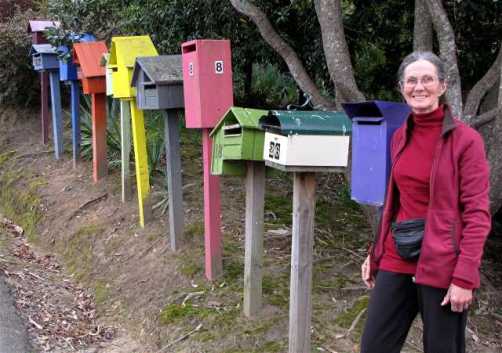When the painter and sculptor Robert Irwin was commissioned to create a garden at the $1.3 billion J Paul Getty Centre in Los Angeles he approached the project as another artwork.
However, Irwin was the first to admit that he knew nothing about plants and Southern California nurseryman Jim Duggan joined the project, collecting plants from Irwin’s long lists, “plus anything else you think is interesting” and growing plants to trial their performance.

The stream path leads into an open space where giant ‘bowers’ for bouganvillea have been constructed from reinforcing rods. Photo: Sandra Simpson
Completed in 1997, the 12,400 square metre Central Garden was, Irwin has said, “a sculpture in the form of a garden, which aims to be art”. More than 500 varieties of plant have been used.
A series of paths forces visitors to walk through every part of the garden while at the same time slowing them down.
The garden follows a natural fall in the land with the first path taking wide zig-zags to a bowl at the bottom, crossing and re-crossing a man-made stream shaded by an avenue of London plane trees (Platanus acerfolia Yarwood).
The water is at first concealed, although it can be heard, by large boulders, becoming more visible on descent.
The stream falls into a round pool containing an azalea maze growing in planter boxes but which looks as if it is floating on the water. The pool is the lowest of four levels of round garden with paths linking the terraces.

A view of the ‘floating’ maze looking back towards some of the museum buildings. Photo: Sandra Simpson
The two outer rings feature mass plantings of Chondropetalum tectorum (Cape rush) and Tulbaghia violacea Silver Lace (variegated society garlic) underneath crepe myrtles (the American-bred Muskogee), while the inner rings are a riot of colour, even at the end of a long, hot summer.

The pale trunks ofthe crepe myrtle Lagerstroemia indica Muskogee, underplanted with Tulbaghia violacea Silver Lace (variegated society garlic). Photo: Sandra Simpson
There are plenty of “ordinary” plants such as dahlias, day lilies, roses, euphorbias, bromeliads, irises, herbs, succulents, hydrangeas, cannas and poppies – but some unusual ones too, including Dalechampia dioscorefolia (purple wings), a vine native to Central America, the red form of Crinum asiaticum (Asiatic poison lily) and Acalypha wilkesiana Haleakala with its bright copper-coloured leaves.

Acalypha wilkesiana is native to the Pacific Islands and is known as copperleaf. This hybrid is Haleakala, named for a volcano in Hawaii. Photo: Sandra Simpson
Among the plants homesick Kiwis will recognise are flaxes, cordylines, hebes, the creeping native fuchsia and coprosomas (which are lightly pruned two to three times a year to stop them getting leggy).
- Entry to the Getty Centre is free, the only charge is for parking, $US15 (if you visit the Getty Villa in the same day – about a 40-minute drive away – the second parking charge is waived.)
This article was first published in the Bay of Plenty Times and appears here with permission. It has been added to slightly.





















